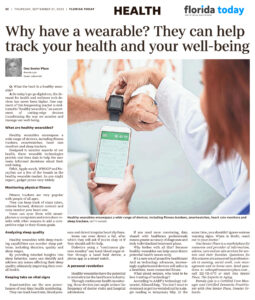
 Brenda Lyle – Florida Today
Brenda Lyle – Florida Today
Q: What the heck is a healthy wearable?
 A: In today’s go-go digital era, the demand for health and wellness tech devices has never been higher. One segment of this burgeoning market is dedicated to “healthy wearables,” an assortment of cutting-edge devices transforming the way we monitor and manage our well-being.
A: In today’s go-go digital era, the demand for health and wellness tech devices has never been higher. One segment of this burgeoning market is dedicated to “healthy wearables,” an assortment of cutting-edge devices transforming the way we monitor and manage our well-being.
What are Healthy Wearables?
Healthy wearables encompass a wide range of devices, including fitness trackers, smartwatches, heart rate monitors and sleep trackers. Designed to monitor aspects of our health, these wearable technologies provide real-time data to help the user make informed decisions about their well-being. Fitbit, Apple watch, WHOOP and Neorythm are a few of the brands in the healthy wearable market. As you might expect, gadget prices vary widely.
Monitoring Physical Fitness
Fitness trackers are very popular with people of all ages. They can keep track of steps taken, calories burned, distance covered, and even monitor your heart rate. Users can sync them with smartphones or computers and even share results with other wearers to add a competitive edge to their fitness goals.
Analyzing Sleep Quality
Healthy wearables with sleep tracking capabilities can monitor sleep patterns, including duration, quality and sleep stages. By providing detailed insights into sleep behavior, users can identify and address any issues affecting their sleep quality, ultimately improving their overall health.
Keeping tabs on vital signs
Smartwatches are the new powerhouses of real-time health monitoring. They can track heart rate, blood pressure, and detect irregular heart rhythms. Some can even detect a fall, after which they will ask if you’re okay or if they should call for help. Diabetics using a “continuous glucose monitor” can track blood sugar either through a hand held device, a phone app or a smart watch.
A personal revolution
Healthy wearables have the potential to revolutionize the healthcare industry. Through continuous health monitoring, these devices just might reduce the frequency of doctor visits and hospital admissions. If you need more convincing, data shared with healthcare professionals means greater accuracy of diagnoses and truly individualized treatment plans.
Why bother with all this? Because healthy wearables can help users detect potential health issues early. It’s a new era of proactive healthcare! And as technology advances, increasingly sophisticated devices will usher in a healthier, more connected future. What about seniors, who tend to be less trusting of technology? According to AARP’s technology columnist, Edward Baig, “You don’t want to overreact or get too weirded out by a single reading or temporary blip. At the same time, you shouldn’t ignore serious warning signs. When in doubt, reach out to your doctor.”
One Senior Place is a marketplace for resources and provider of information, advice, care and on-site services for seniors and their families. Questions for this column are answered by professionals in nursing, social work, care management and in-home care. Send questions to AskOSP@OneSeniorPlace.com, call 321-751-6771 or visit One Senior Place, The Experts in Aging.
Brenda Lyle is a Certified Care Manager and Certified Dementia Practitioner with One Senior Place, Greater Orlando.


